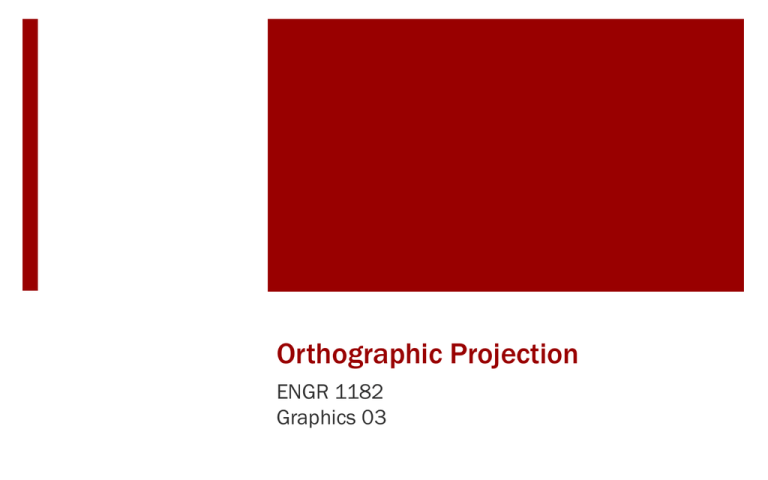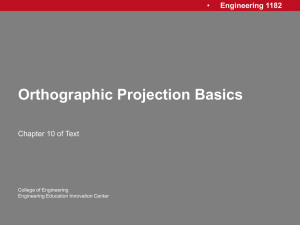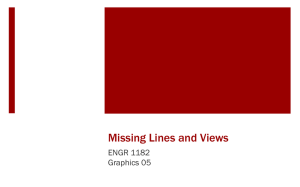Orthographic Projection: Engineering Graphics Presentation
advertisement

Orthographic Projection ENGR 1182 Graphics 03 Today’s Objectives Creating Orthographic Projections • Basics • Hidden Lines GP03 In-Class Activity GP03 Out-of-Class Homework Assignment Orthographic Projections Orthographic projections are another way to represent 3D objects in 2D space By using multiple orthographic drawings, we eliminate any misinterpretations that isometric views allow Hidden lines show features that are not visible from that view Multiple views of an object determine where to include hidden lines in orthographic drawings Orthographic Projection Basics ENGR 1182 Graphics 03 Drawing Orthographic Views One way to visualize objects in orthographic is to imagine the object inside a glass box. Imagine that the object is projected onto each surface of the glass box. The box is then unfolded to form the multiview drawing. Requiring Multiple Views A single projection can not fully describe the object This single view can be interpreted in at least 6 different ways! To completely describe the object we use multiple views In general, the front, top, and right side views are used to represent an object Visualizing in Orthographic Use your snap cubes to build the following object. Look at if from the front, right, and top sides. Top Top 2 1 Front 2 Note: These are the 3 views associated with the object you just built. Right Front CLICK Right Complete Multiview Drawings • Right: height and depth A B Height B Height • Front: height and width B A Each view only shows 2 dimensions: • Top: width and depth B Depth The views are aligned so that corresponding points are lined up between views. Width Height The front, top, and right side views are required to fully describe an object A A Width Depth CLICK In-Class Activity (GP03) Hidden Lines in Orthographic Projection ENGR 1182 Graphics 03 Hidden Lines Hidden lines are shown as dashed lines, and depict edges that are not visible from the current viewpoint Using the coded plan shown, sketch the isometric view of the object from the z-corner Which edges would appear as hidden lines in an orthographic drawing? Front Hidden Lines These are the orthographic views that correspond to the object you just built Top Hidden lines Front Front Right Hidden Lines Hidden lines are dashed lines used to represent internal features that are obscured by the object. These hidden lines represent the obscured corner of the notch. This hidden line represents the obscured edges of the notch. These hidden lines show the extents of the hole. CLICK Line Precedence Visible lines take precedence over all other lines Hidden lines take secondary precedence If visible and hidden lines overlap, only the visible line is shown Line Precedence Example Potential hidden line Potential hidden line Visible lines take precedence Note that the two potential hidden lines in this sketch fall directly behind visible lines in the right side view. The visible lines take precedence and the hidden lines are not shown. In-Class Assignment (GP03) Important Takeaways Orthographic drawings are another way to represent 3D objects in 2D space Top, front, and right views are required to fully describe an object Hidden lines show features that cannot be seen from the current viewpoint Hidden lines have secondary precedence to visible lines What’s Next Due Next Class: GP03 Out-of-Class HW Inclined and Curved Surfaces in Orthographic Projection • Adding inclined planes and curved features to orthographic projection • Increasing clarity by adding center marks and centerlines Point, Edge, and Surface Tracking • Identifying corresponding points, edges, and surfaces between orthogonal views Take Graphics 4 Quiz on readings



